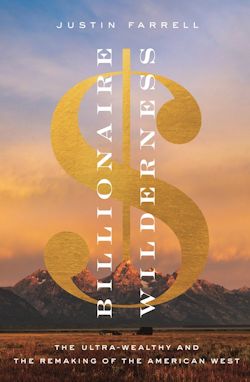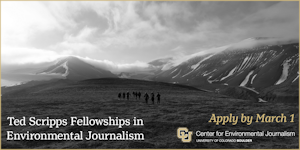SEJournal Online is the digital news magazine of the Society of Environmental Journalists. Learn more about SEJournal Online, including submission, subscription and advertising information.
BookShelf: “Billionaire Wilderness: The Ultra-Wealthy and the Remaking of the American West”
By Justin Farrell
Princeton University Press, $27.95
Reviewed by Jennifer Weeks
 |
Home to both Grand Teton and Yellowstone national parks, Wyoming’s Teton County has some of the world’s most spectacular natural beauty.
It’s also America’s richest county in per capita income, and it has the nation’s highest level of income inequality.
Yale University sociologist Justin Farrell spent five years in Teton County researching “Billionaire Wilderness: The Ultra-Wealthy and the Remaking of the American West.” It’s an eye-opening look at how extreme wealth is remaking this region.
It’s an environmental book because, as Farrell convincingly shows, “the ultra-wealthy use nature to resolve key predicaments in their lives.” And the choices they make have widespread impacts.
Assuaging guilt through conservation
Through extensive interviews, Farrell shows that extremely wealthy people who have flocked to places such as Teton County since the early 2000s are seeking solutions to two deeply felt problems.
The first is economic: What’s the best way to “enjoy, share, protect, and multiply” their wealth?
The second is social: How should they respond to social stigmas and feelings of personal guilt and illegitimacy associated with amassing so much money?
Buying land and building showpiece homes in a place like Teton County is financially smart. Wyoming has no income tax and is consistently ranked as America’s most wealth-friendly state, so rich families benefit just by relocating there for part of the year.
And when they start investing in conservation – typically, land protection – the savings increase.
“[A] lot of times it’s somebody who’s made a killing in the stock market, and now needs to offset their income with a huge tax deduction. Conservation easements are one popular way to make this happen,” a local resident tells Farrell.
But in a county where 97 percent of the land is publicly owned and protected from development, those easements drive up prices. That worsens an affordable-housing shortage that has priced out the middle class, creating a barbell-shaped income distribution where nearly everyone is extremely wealthy or extremely poor.
Helping area’s poor a ‘buzz-kill’
Many of Teton County’s working poor residents are Hispanic who moved to the region for its service jobs. Their typical household income is in the mid-$20,000s, even though it’s common to hold two or three jobs.
For housing, they may squeeze two families into a two-room mobile home or drive 50 miles each way to work over Teton Pass.
An auto mechanic comments that
his rich neighbors ‘take care of the
wolves more than the Latino
workers in this community.’
Wealthy residents say their spending brings jobs and boosts local charitable giving. But Farrell examines philanthropic records and shows that most giving flows to environmental and arts organizations.
Social service and aid organizations receive far less; one wealthy resident refers to those agendas as “buzz-kill” issues.
Few of Teton County’s wealthy understand that their giving patterns make inequality worse. But the working poor are on to them.
An auto mechanic comments that his rich neighbors “take care of the wolves more than the Latino workers in this community.” Another resident describes the ultra-rich as “flying around in a jet and talking about how much I wanted to save the moose.”
Similar drama plays out across West
Most Teton County billionaires will be startled to read these comments.
As Farrell shows, living in Wyoming helps them assuage deep worries that they have lost something in the process of becoming rich.
Establishing a connection to nature is their answer:
“This longing for cultural authenticity plays out in the ways they construct their homes, the books on their shelves, the art on their walls, statues on their floors, and the clothes on their bodies. … [This idealized view of the West] opens up the possibility of access to a primordial America where life was simpler, and honest rural values of the noble native, the dusty cowboy, and the homesteader prevailed, all against the backdrop of untamed Nature.”
Many billionaires whom Farrell meets dress in Wrangler jeans and flannel shirts, drive pickup trucks and insist that no one in the community cares about money.
They also view their relationships with working-class residents as genuine friendships, although these connections virtually all involve economic transactions.
Some justify their wealth by asserting that they’ve made different choices from locals who, as the billionaires see it, choose to be ski bums because they prefer adventure to affluence.
This drama is playing out in other communities across the West, Farrell notes.
In places like Bozeman, Boulder, Taos, Boise and Lake Tahoe, and the exurbs of San Francisco, Seattle and Denver, affluent people are using conservation in ways that justify vast consumption of natural resources, increase existing inequality and make philanthropy overly dependent on small circles of wealthy donors.
All this makes the book a great read for anyone interested in the intersection of conservation and inequality in the West.
Jennifer Weeks is environment and energy editor at The Conversation U.S., based in Boston, a former SEJ board member and a regular contributor to SEJournal Online BookShelf.
* From the weekly news magazine SEJournal Online, Vol. 5, No. 24. Content from each new issue of SEJournal Online is available to the public via the SEJournal Online main page. Subscribe to the e-newsletter here. And see past issues of the SEJournal archived here.














 Advertisement
Advertisement 



